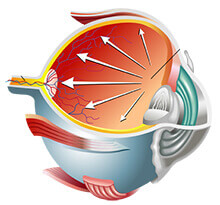 Selective laser trabeculoplasty (SLT) is an advanced surgical treatment for open-angle glaucoma, one of the many types of glaucoma. This procedure results in a biological response that:
Selective laser trabeculoplasty (SLT) is an advanced surgical treatment for open-angle glaucoma, one of the many types of glaucoma. This procedure results in a biological response that:
Selective laser trabeculoplasty is typically recommended:
In order to drain excessive pressure-causing fluid in your eye, SLT uses short pulses of low energy laser light to remove cells that are interfering with proper drainage through the trabecular meshwork.
To better understand open-angle glaucoma and SLT, it is helpful to first understand how eye pressure works:
The eye is constantly making new fluid (called aqueous humor) to keep the front of the eye filled. At the same time, a matching supply of fluid is constantly leaving the eye. The balance between the volume of fluid made and how much leaves determines the pressure within the eye.
In a normal eye, fluid drains by passing between the iris and crystalline lens before leaving through the drain called the trabecular meshwork. In open-angle glaucoma, this flow of fluid is blocked inside the drain itself by pigmented (melanin) cells.
When the amount of aqueous humor leaving is not enough, the pressure within the eye increases, much like a balloon filled with too much water – fluid is coming in, but not enough is going out. This increase in pressure is what usually leads to glaucoma. Glaucoma occasionally occurs without high pressure.
A laser uses light to deliver a type of concentrated energy capable of removing unwanted tissue cells. The laser needs to be precisely positioned to target pigmented cells blocking the trabecular meshwork in your eye. In order to do this, Dr. Seibel will ask you to sit in front of an instrument called a slit-lamp. This is the same instrument that is used during an eye exam. A slit-lamp is actually a type of microscope, so the laser energy will be focused with extreme accuracy.
The laser used in this procedure delivers a specific wavelength of light capable of selectively targeting the blocking cells, without affecting the surrounding tissue. This substantially lowers any risk and allows for multiple re-treatments if necessary.
Selective laser trabeculoplasty lowers intraocular pressure by using short pulses of low-energy laser light to target cells clogging the trabecular meshwork of the eye. The following is what you may expect:
In general, there are no restrictions in activity following the laser treatment. You may return to your normal daily routine, although driving might not be advised right away. Your may be required to continue using eye drops for a few days following your laser treatment. Several postoperative visits will be scheduled to monitor your eye pressure.
The goal of selective laser trabeculoplasty is to help you avoid more invasive surgery and reduce your dependence on eye drops. Occasionally, even after SLT, the drainage opening can become blocked again. If this occurs, the procedure may be repeated and is often successful.
The quality of your vision will not be improved by SLT. The purpose of the procedure is to preserve your vision, not to make it better.
Serious complications with selective laser trabeculoplasty are extremely rare. The main risk is that the effect of the surgery may wear off over time and need to be repeated. Other risks are minimal but may include inflammation, transitory intraocular pressure spike, conjunctivitis, or eye pain. Unlike some glaucoma medications, there are no incidences of allergy or systemic side effects with SLT.
Prior to the introduction of selective laser trabeculoplasty, argon laser trabeculoplasty was the surgeon’s method of choice. We thought it might be helpful for you to read about the differences.
Unlike ALT, selective laser trabeculoplasty is repeatable several times. While argon laser trabeculoplasty patients can receive 2 treatments in a lifetime, SLT patients can receive 2 treatments a year.
Both selective laser trabeculoplasty and argon laser trabeculoplasty produce equivalent drops in intraocular pressure, however SLT has also been found to be effective in cases where ALT and other forms of treatment have failed. This includes patients who have already been treated with argon laser trabeculoplasty.
At Seibel Vision Surgery, your eyes and vision are of paramount importance. To help you make the most informed decisions regarding the welfare of your vision, we are delighted to be of service and are happy to answer any questions you may have.
Please take the time to familiarize yourself with the information contained on this site. We have compiled it especially for you!
Monday, Tuesday, Wednesday, and Thursday
8:30 a.m. to 3:30 p.m.
Friday
8:30 a.m. to 3:00 p.m.
OUR ADDRESS
11620 Wilshire Boulevard, Suite 711
Los Angeles, California 90025
PHONE
(310) 444-1134
FAX
(310) 444-1130
Learn about cataracts and their treatment
Learn more about CataractsGlaucoma, Macular Degeneration,
Medical Eye Exams, and other